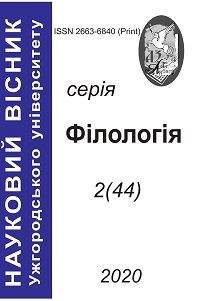EFFICIENCY OF NATIVE LANGUAGE EDUCATION IN THE TRANSCARPATHIA BASED ON A REPEATED QUESTIONNAIRE SURVEY (2008–2018)
DOI:
https://doi.org/10.24144/2663-6840.2020.2.(44).136-140Ключові слова:
language attitude, native language variant, Transcarpathian school students, stereotypes.Анотація
During our research, we wish to find out whether the native language education reform of 2005 brought any positive changes in teaching the common language norm in the Hungarian schools in Transcarpathia. The research conducted last year (20 schools, 280 students) proved that additional native language education has a spectacular result: young people have a far more positive, objective attitude towards non-common language versions. By all means it is also worth to know whether any such changes can be discovered concerning the use of language phenomena observed with the help of the three task types. Based on an earlier survey it was proven that changes can actually be observed concerning the opinion about lan- guage dialects since the Hungarian language curriculum of 2005 became effective. This change is clearly positive. Students showed benevolence concerning language dialects, dialect speakers in far larger proportion than earlier. And it is not only present in the field of numbers. Their explained opinion also shows a more objective, rational view. Whether we look at the approach to, perspectives of the concept of language dialects, or the reasoning of their answers based on emotional attitude (e.g. Would you feel sorry if dialects died out?). It is clearly an efficient change compared to the earlier data that while in the course of the previous survey the situation of the minorities, borrowed elements were not mentioned concerning the local language variants (or if they were, then in a negative context). These changes are clearly due to the additive attitude and the secondary school textbooks prepared in this view.
Such clear changes cannot be observed concerning tasks about common language norm awareness. Small differences can be seen concerning a few phenomena in the percentage of standard answers: in the case of using -nák, the future tense of the predicate kell. Studying the adverb of place suffix -nál/-nél used instead of -hoz/-hez/-höz and -tól/-től in a comparative function only shows an increase in percentage in the case of sentence correction tasks. This indicates that in the past 10 years representatives of the studies age group became somewhat more aware.
The changed attitude that can be found in the Hungarian language curriculum in Transcarpathia and in the Hungarian language textbooks is by no means favorable for this positive change.

